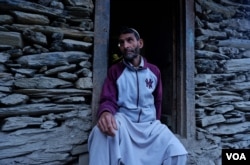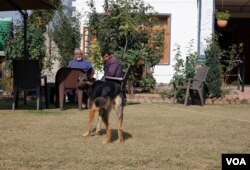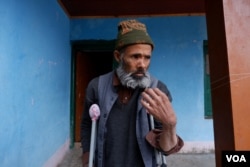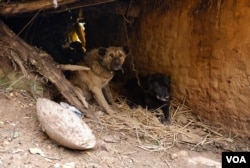Fourteen-year-old Shahid Ahmad Ganai took his family's cows for grazing some 200 meters away from his house in Trikanjan, a hilly terrain on the Indian side of Kashmir.
But that Sunday afternoon was interrupted with sudden screams. His father, Abdul Jabbar Ganai, 52, and mother, Parveena Begum, 47, frantically ran towards the grazing spot in the remote Boniyar village neighborhood of Baramulla district.
"We rushed toward the spot and saw our youngest son, Shakir, rushing toward us in a state of shock," said Ganai, describing what happened on June 12. "He [Shakir] told us that Shahid was attacked by a leopard. Both of us ran as fast as we could to save our son, but all in vain," the distraught father said while pointing towards the site.
Located in the foothills of the Himalayas on the Indian side of Kashmir, the region has about 24,214 square kilometers of forest land constituting around 20% of its total geographical area, including five national parks, 14 wildlife sanctuaries and 35 conservation reserves, official figures show.
The region's forests host several types of wildlife including leopards, bears and wild boars. Humans and animals rarely used to cross each other's paths but in the past two decades, wildlife experts say the "frequency of interactions" between the two has increased.
Data provided by the local wildlife department claims some 234 people have been killed and 2,918 others injured from January 2006 to November 2021 due to man-wildlife conflict across the Kashmir region.
Five leopards and 17 bears were killed after being declared "man-eaters" under subsection [6] of section 11 of the Wildlife Protection Act, 1972 of India since 2011.
The mutilated body of Shahid was found deep inside the forest by locals accompanied by police and wildlife officials. The same leopard is said to have struck in another village of Boniyar just two days later on June 14.
The leopard mauled a 12-year-old girl identified as Rutba Manzoor when she was playing outside her house. Manzoor's family refused VOA's request for comment, with one of the family members saying that they don't want to relive the tragedy and are removing themselves from "anything that disturbs our mental peace."
In just four months, Ganai said five children and more than 50 sheep were killed by the leopard in 11 encounters, leading the residents of Boniyar to hit the streets asking for Jammu and Kashmir Wildlife Department to hunt the animal down.
"Locals, police and wildlife officials killed the leopard after several days of search," Ganai said. "Many lives would have been saved had wildlife officials issued an order to kill the leopard soon after the first incident," the grieving father added.
Man-animal conflict factors
Mehreen Khaleel, a primatologist and head of Wildlife Research Conservation Foundation, or WRCF, a Kashmir-based NGO, says the interaction between humans and animals in the Kashmir valley has increased in the last two decades, but notes there are additional factors for such conflicts.
"We don't have enough data to support the cause of these increased interactions. Non availability of prey, increased disturbance in wild habitats, change in land use patterns in fringe zones are a possible few of the reasons," Khaleel said. "The large-scale shift from agriculture to horticulture in fringe zones, reduction of escape spaces, closure of natural animal corridors has increased the occurrence," she said, adding that climate change also has played a greater role considering the geographic location of the Kashmir region.
Man-animal conflict in the Kashmir valley is not only confined to the areas closer to forests. The presence of wild animals such as bears, porcupines and leopards have been found in many parts of central Kashmir.
In September, a female bear and her cub were caught by a joint team of police and wildlife department officials from Rajbagh neighborhood of Srinagar city after their movement was spotted inside a posh residential area with the help of CCTV cameras.
On June 4, 2021, Adha Shakil, a 6-year-old girl, was playing with her doll inside the lawn of her two-story house in the Ompora area of central Kashmir's Budgam district when a leopard attacked her and took her to a nearby forest nursery.
"Everything happened in a matter of a few seconds," the victim's grandfather, Ghulam Hassan Mir, told VOA. "She just screamed, and I came out running to see what happened to her. She was missing and the doll she was carrying in her hands was lying on the ground. I immediately figured out that it was a leopard attack and Adha won't return alive."
Mir said rumors about the presence of the leopard inside the area had been heard for over two years.
"Today people are scared that the incident might repeat in [the] future," Mir said. "It seems that there is no value for a human life in Kashmir, otherwise the government would have ordered for the conversion of a forest nursery into a park," he said, adding the forest department cut a few trees, which according to him is not enough to create safety for people.
"Thousands of people consisting of civilians, army, police and wildlife officials," Mir said, failed to trace the dead body of his granddaughter until the next afternoon.
"One needs to understand how dense this forest nursery is," he said. "Moreover, people are claiming that one more leopard is present inside it [the forest] as many local residents claim have found fresh footprints of the wild animal. Government will act only after another fatal incident."
Aliya Mir, a wildlife rescuer associated with Wildlife SOS, disagrees that human-animal conflict has increased, saying instead that the reporting of such incidents has increased.
"There was a communication gap between people and the wildlife department due to which such incidents did not use to come into the notice," Aliya told VOA. "Bridging the gap between the people and the wildlife department has reduced casualties, as the department has set control rooms in every district to address emergency and rescue calls."
Long-term impact
Lying on a torn mattress, inside a dark room of his single-story mud and brick house, Mohammad Yousf Kohli, 70, cannot walk without underarm crutches as one of his feet was damaged completely following a bear attack near a grazing area in Check-Dard-Khor, a remote village in district Srinagar.
"I was sitting watching my sheep grazing and all of sudden a giant bear came out of bushes and attacked me," Kohli said, adding his pet dog saved his life by attacking the bear. "For three days I remained unconscious inside the hospital. I received injuries on my head, neck, arms and foot."
Kholi told VOA that his family suffered financially as the money earned in the last five years was spent on his treatment.
"We have nothing left at our home. The incident made our financial condition from bad to worse," he said, adding that he did not receive compensation from the government. "I used to support my family but now I have become their liability."
There are frequent bear attacks in Check-Dard-Khor, Kholi says, as people spot them regularly especially during evening hours.
"People are scared to move out in the evening," he said. "Most of the families living in our area have purchased dogs so that they can have an idea about the presence of wild animals roaming here."
Compensation for victims
Rashid Naqash, Kashmir zone wildlife officer, told VOA that his department is doing everything it can to prevent man-animal conflict. He says wildlife officials regularly conduct awareness programs in attack-prone areas.
Naqash says the government provides rupees three lakh ($3,645) as compensation to the families of the slain victims and people with serious injuries.
"Besides the compensation, we have deposited rupees one crore ($16,4059) at the state-run hospital, Sher e Kashmir Institute of Medical Sciences, for the treatment of the injured people," he said.
But families of victims say the compensation is often delayed. Ganai's family says they have yet to receive any money five months after the tragedy.
"I plan to construct a new house which will have basic facilities such as an internal washroom," Ganai, the father, said. "Our area is prone to leopard attacks, and we are scared to go to the washroom in the evening or at night as we have to cover a lot of distance. I, being a poor man, can't afford to do anything without money. My only hope is the compensation amount and I need it immediately to secure the lives of my family members."
Naqash told VOA that the Kashmir zone wildlife department usually gives out money based on priority, but in some cases, it takes some time due to technical issues.
"Everyone will get compensation soon. Jammu and Kashmir Wildlife Department is committed to its promises," he said.
Khaleel, the primatologist, believes there will be a spike in man-animal interactions in the coming years as animals are losing their habitats as well as their prey. Additionally, she warned, an "increase in population of invasive species such as wild-boar and porcupine" might exacerbate the existing problem and she recommended that "it needs to be managed at the earliest."










